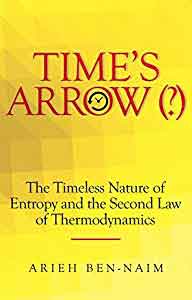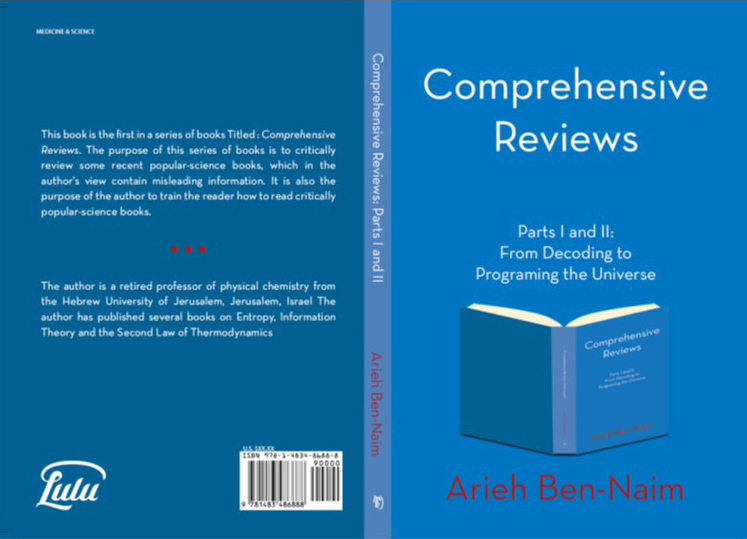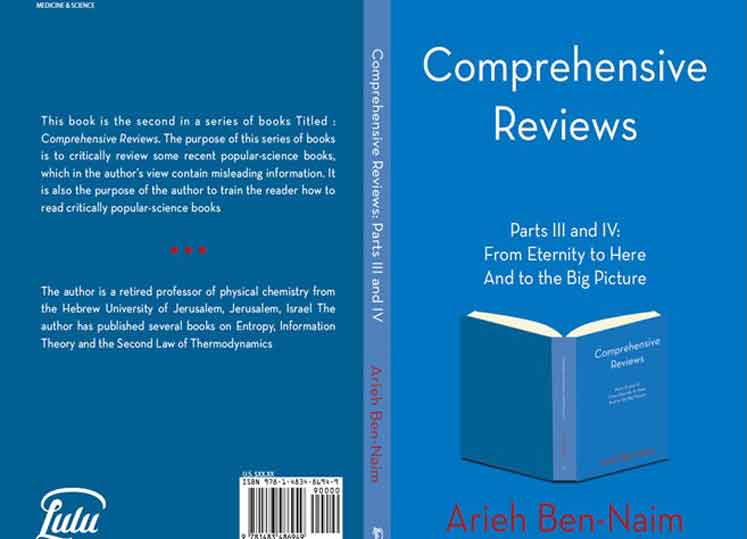Home | About Us | Contact Us
Hebrew University, Jerusalem, Israel AriehBenNaim@gmail.com ( 972) 2 6454554
©Copyright 2005- Sites To Remember




misleading and mysterious term “entropy” with a more familiar, meaningful and appropriate term such as information, missing information or uncertainty. This replacement would facilitate the interpretation of the “driving force” of many processes in terms of informational changes and dispel the mystery that has always enshrouded entropy. It has been 140 years since Clausius coined the term “entropy” almost 50 years since Shannon developed the mathematical theory of “information” - subsequently renamed “entropy”. In this book, the author advocates replacing “entropy” by “information”, a term that has become widely used in many branches of science. The author also takes a new and bold approach to thermodynamics and statistical mechanics. Information is used not only as a tool for predicting distributions but as the fundamental cornerstone concept of thermodynamics, held until now by the term “entropy”. The topics covered include the fundamentals of probability and information theory; the general concept of information as well as the particular concept of information as applied in thermodynamics; the re-derivation of the Sackur-Tetrode equation for the entropy of an ideal gas from purely informational arguments; the fundamental formalism of statistical mechanics; and many examples of simple processes the “driving force” for which is analyzed in terms of information.
It will raise the awareness of the reader on the vital importance of water to all life on earth. It is a book of science interwoven into the fabric of a story. There are very few books on water aimed at the general public. This volume will appeal to both adults and students with its superb delivery of scientific knowledge in highly accessible prose.
In the first part, the reader is asked to play the familiar twenty-Question game. Once the reader feels comfortable with playing this game and acquires proficiency in playing the game effectively (intelligently), he or she will be able to capture the elusive and used-to-be mysterious concept of entropy. There will be no more speculative or arbitrary interpretations, nor “older” or “modern” views of entropy. This book will guide readers in choosing their own interpretation of entropy. Readership: Undergraduate and graduate students in chemistry and physics, academics and lay persons.
misleading and mysterious term “entropy” with a more familiar, meaningful and appropriate term such as information, missing information or uncertainty. This replacement would facilitate the interpretation of the “driving force” of many processes in terms of informational changes and dispel the mystery that has always enshrouded entropy. It has been 140 years since Clausius coined the term “entropy” almost 50 years since Shannon developed the mathematical theory of “information” - subsequently renamed “entropy”. In this book, the author advocates replacing “entropy” by “information”, a term that has become widely used in many branches of science. The author also takes a new and bold approach to thermodynamics and statistical mechanics. Information is used not only as a tool for predicting distributions but as the fundamental cornerstone concept of thermodynamics, held until now by the term “entropy”. The topics covered include the fundamentals of probability and information theory; the general concept of information as well as the particular concept of information as applied in thermodynamics; the re-derivation of the Sackur-Tetrode equation for the entropy of an ideal gas from purely informational arguments; the fundamental formalism of statistical mechanics; and many examples of simple processes the “driving force” for which is analyzed in terms of information.
It will raise the awareness of the reader on the vital importance of water to all life on earth. It is a book of science interwoven into the fabric of a story. There are very few books on water aimed at the general public. This volume will appeal to both adults and students with its superb delivery of scientific knowledge in highly accessible prose.
In the first part, the reader is asked to play the familiar twenty-Question game. Once the reader feels comfortable with playing this game and acquires proficiency in playing the game effectively (intelligently), he or she will be able to capture the elusive and used-to-be mysterious concept of entropy. There will be no more speculative or arbitrary interpretations, nor “older” or “modern” views of entropy. This book will guide readers in choosing their own interpretation of entropy. Readership: Undergraduate and graduate students in chemistry and physics, academics and lay persons.

This book is unique in the following senses: 1, it provides three different, but equivalent definitions of Entropy. 2, it provides a simple, valid, and proven interpretation of Entropy, and the Second Law of Thermodynamics based on Shannon's Measure of Information. 3, this is the only book that proves that Entropy is not a function of time.
misleading and mysterious term “entropy” with a more familiar, meaningful and appropriate term such as information, missing information or uncertainty. This replacement would facilitate the interpretation of the “driving force” of many processes in terms of informational changes and dispel the mystery that has always enshrouded entropy. It has been 140 years since Clausius coined the term “entropy” almost 50 years since Shannon developed the mathematical theory of “information” - subsequently renamed “entropy”. In this book, the author advocates replacing “entropy” by “information”, a term that has become widely used in many branches of science. The author also takes a new and bold approach to thermodynamics and statistical mechanics. Information is used not only as a tool for predicting distributions but as the fundamental cornerstone concept of thermodynamics, held until now by the term “entropy”. The topics covered include the fundamentals of probability and information theory; the general concept of information as well as the particular concept of information as applied in thermodynamics; the re-derivation of the Sackur-Tetrode equation for the entropy of an ideal gas from purely informational arguments; the fundamental formalism of statistical mechanics; and many examples of simple processes the “driving force” for which is analyzed in terms of information.
It will raise the awareness of the reader on the vital importance of water to all life on earth. It is a book of science interwoven into the fabric of a story. There are very few books on water aimed at the general public. This volume will appeal to both adults and students with its superb delivery of scientific knowledge in highly accessible prose.
In the first part, the reader is asked to play the familiar twenty-Question game. Once the reader feels comfortable with playing this game and acquires proficiency in playing the game effectively (intelligently), he or she will be able to capture the elusive and used-to-be mysterious concept of entropy. There will be no more speculative or arbitrary interpretations, nor “older” or “modern” views of entropy. This book will guide readers in choosing their own interpretation of entropy. Readership: Undergraduate and graduate students in chemistry and physics, academics and lay persons.



Enter text or HTML markup here.